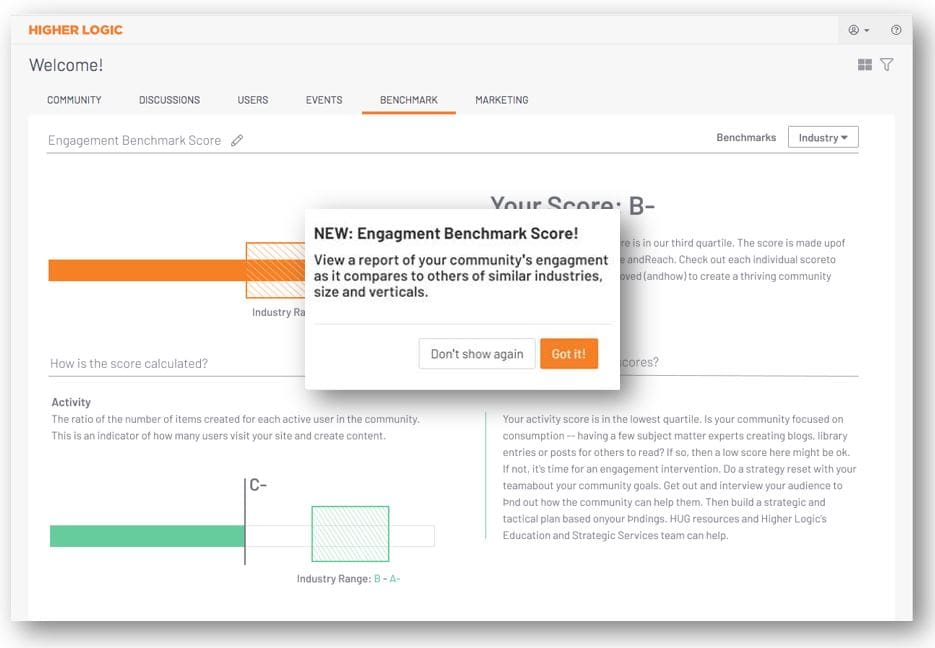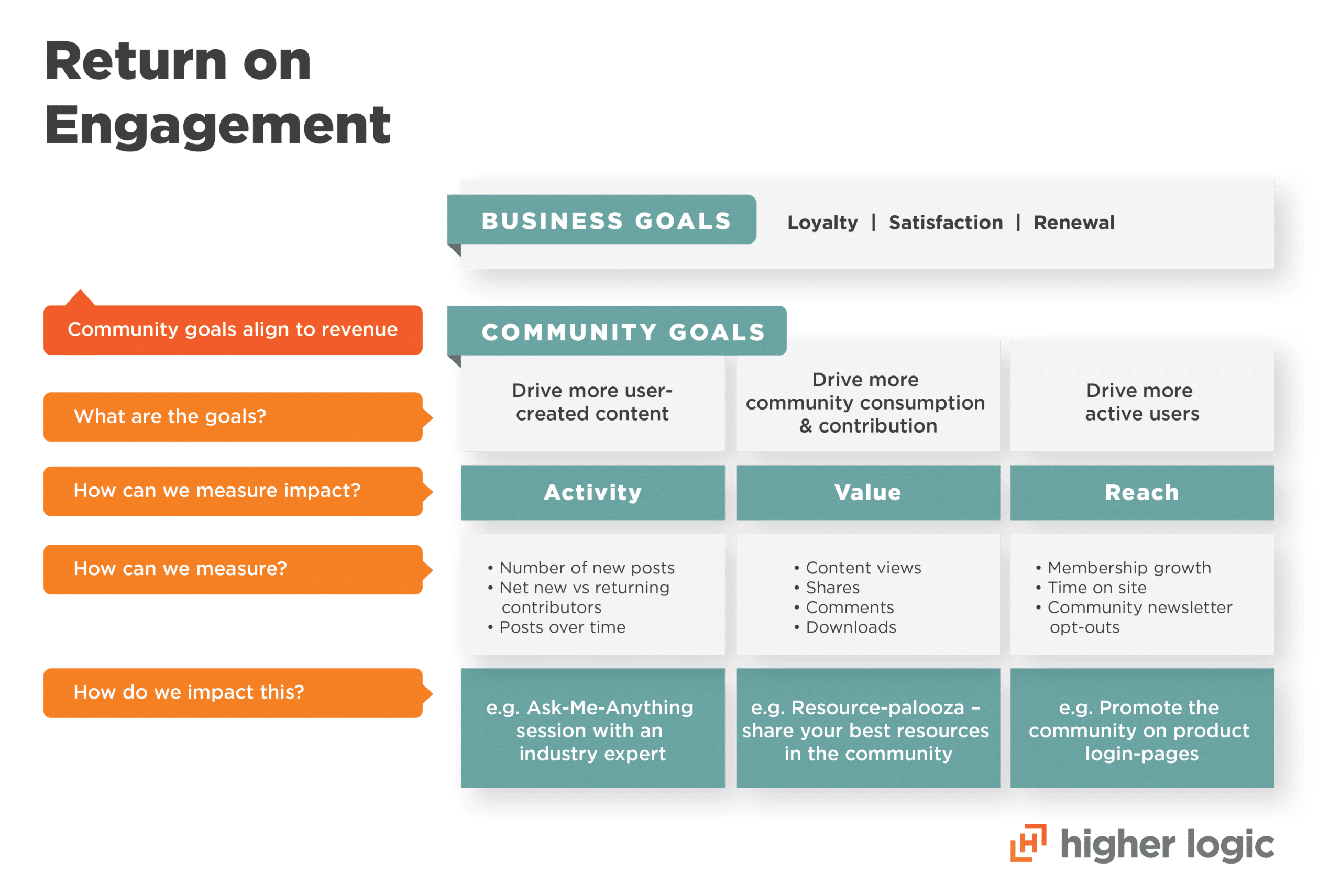
Return On Engagement is the New Way to Measure the Value of Your Community
We’re introducing a new and better way to measure online community value: Return on Engagement. ROE aligns community engagement to business goals.
According to CMX’s 2021 Community Industry Report, only 12% of those surveyed can quantify the business value of their community. Meanwhile, other survey data points to online communities achieving objectives like increased customer loyalty and improved customer experience.
We all know intuitively that creating closer, deeper connections with our members and customers can positively impact organizational goals like retention, satisfaction, and loyalty. When members or customers are connected in a space where they can talk about the industry, share feedback, and make connections, they’ll not only become more successful – but our own organizations gain insight into their needs, feedback, and priorities, ultimately improving our ability to provide more valuable products, services, and experiences.
So why are so many community professionals unable to quantify the business value of online community engagement, when it’s obviously so important?
Could the problem be the approach?
Community professionals want and need to measure and prove value of their community programs – but as CMX’s data shows, proving that connection is difficult.
For so long, community professionals have struggled with the narrow return on investment (ROI) model to quantify value – dollars in, dollars out. While ROI calculations are valuable, they can also be time-consuming to derive, which makes it difficult to measure the direct impact of engagement programs and tactics.
We believe there’s a better way to measure the incredible value online communities can have on organizations. It’s all about engagement, since that’s what drives online community’s value for businesses and customers. How active is your online community, how valuable is the content being shared, and how far is the message being spread?
Introducing a new and better way to measure online community value: Return on Engagement.
In this piece, we’ll look at:
- What is Return on Engagement?
- Why Return on Engagement is the New ROI for Online Communities
- What Makes Up Return on Engagement
- How to Measure Return on Engagement
- 4 Steps Toward Activating Return on Engagement
What is Return on Engagement (ROE)?
The best way to measure value on your community program is through the engagement it produces and the results it leads to.
This is called the Return on Engagement or ROE. ROE is a method for communicating the value, measuring, and managing the success of your community programs. It aligns community engagement directly back to business goals by connecting community engagement back to business value. ROE has three key components: Activity, Value, and Reach.
Why ROE is the New ROI for Online Communities
ROE works differently from ROI because it’s not only measuring the basic input, output, investment value, it’s also measuring the entirety of your online community program’s impact. It’s measuring quantifiable and qualitative interactions your customers or members are having with your organization. With ROE, you get a holistic look at engagement and a broader capture of value, as well as more tactical levers that you can use to drive more engagement and deeper connection.
A holistic look at engagement
While ROI measures a one-to-one input against output (what you spend compared to the money you get back), ROE looks holistically at the entire community program’s value, based on behavior.
Broader value capture
ROI metrics for communities are tied to other processes and systems (such as support ticket resolution) or may be parsed to only measure the return on one single community program or impact.
ROE identifies value across the organization by measuring activity that correlates with organizational success.
Let’s look at an example to illustrate the differences between the ROI and ROE approach.
- ROI approach: How can I get more customers into my online community to answer each other’s questions quickly so that more support tickets are deflected and costs are cut?
- ROE approach: How can I get more customers into the community, more often and for longer periods of time, interacting with more content and participating in more activities, because I know that increased engagement increases value both for the customer and my organization?
The support ticket metric is narrow and looks only at one aspect – cutting costs through scaled support – rather than seeing the community engagement program holistically and its impact on the business’ growth as a whole.
“Our last community platform provider was more of a ‘break-fix’ kind of situation. Now, on Higher Logic, we’re working to make our community a destination. When we meet people at our user groups, we bring them into the community to continue those conversations in a virtual forum, so that it’s a place where they want to stay, rather than solve a problem once and then leave.”
Michael Torok, Director of Knowledge and Community, Delphix
Of course, support ticket deflection through peer-to-peer support is still valuable and a part of ROE.
What Makes Up Return on Engagement?
The three main aspects of a community’s Return on Engagement are Activity, Value, and Reach.
Activity: How lively is your online community? Simply put, how many users are coming to your site, and how many of them are creating, consuming, and interacting with content? Activity is a core metric not only because content is the key driver of value for your audience, but also because it motivates others to interact.
Value: How useful/meaningful/important is the content being created? This is a measure of the engagement that is generated by the content in the community. This is an important gauge of the quality and relevance of the content being created.
Reach: How wide is the influence? How much of your customer or member base is interacting with your content, and who are they? In a community setting, this would include the ratio of users who are active in the community compared to the available audience. We found in our research users who spent more time on the site were more likely to create content, so getting them to the site is a critical first step of the engagement journey.
Measuring Activity, Value, and Reach as part of ROE should help you identify whether your organization is encouraging behaviors that lead to further engagement.

How to Measure Return on Engagement
If you want to measure your Return on Engagement, start by building a plan. Ask yourself these key questions:
- What are my organization’s goals?
- What are my community’s goals and how do they align to my organization’s goals?
- What is the maturity level of my community?
- What is my community strategy and how does it align to my community goals?
- What are my community tactics to execute that strategy?
- How will I measure the success of those tactics?
When looking at what kinds of business goals your community engagement can impact, it helps to understand both the quantitative and the qualitative returns of engagement.
| Quantitative results of engagement | Qualitative results of engagement |
|
|
Once you’ve identified your organization’s goals, connect them back to Activity, Value, and Reach and the metrics they cover (such as the number of new posts, content views, or time on site), and implement online community engagement tactics to help you achieve these goals. There are many metrics in each category – you determine which are right for your goals and situation – but be sure you’re looking across all three.
Return on Engagement at work: The American Society of Association Executives found that community users with at least 1 activity per month generate 5x more revenue than users with one activity or fewer per month.
If you look at it from the bottom up, from the community manager’s perspective, it’s thinking through how your tactics affect Activity, Value, and Reach, how those affect your community’s goals, and how those affect your organization’s goals.

But what if you don’t have an online community yet – or you have an online community, but you’re not sure how to connect it to your business goals?
4 Steps Toward Activating Return on Engagement
Try these proven steps to activate Return on Engagement at your company.
1. Build an online community on a platform designed for engagement.
The first and most important step toward activating ROE is to create a space for your customers or members to engage – an online community. And you need a platform that’s designed for engagement if you want to see ROE.
To increase engagement with all of your stakeholders – all your customers, users, members, partners, employees – create a distinct, unique destination and experience to help them connect, create, and innovate together.
Create a content strategy that speaks to the needs and interests of your community members. Leverage best practices and features like automation rules, gamification, and segmentation tools (built into Higher Logic’s online community platform) to help you scale engagement.
An automation rule can help you do things like get an uninvolved customer back into the community. Let’s say they haven’t logged in for 30 days – an automated email, personalized with your content, is triggered to that user telling them they’re missed.
As you go, listen to your members, build many-to-many and one-to-one conversations, invite and inspire participation. Then measure results and repeat.
2. Make your online community the member/customer hub.
To follow through on your community strategy, you need to make your online community the hub for member or customer engagement. Of course, you’ll also need other engagement activities, like email marketing and communications, one-on-one conversations with Customer Success Managers, regular check-ins with your membership team, and meeting at virtual/hybrid events.
But if your members or customers know that they can find everything they need and links to important sites in the online community, they’ll get into the habit of going to the community to get questions answered, find advice, access resources, and connect with other users.
3. Get all departments involved.
With an online community, you can provide a streamlined experience for customers or members from across your staff. You can also share more expert answers from the right employees across your organization. For example, if you can get your product team or your member services team engaged in the community, this is a great way to give more valuable answers: breaking down silos between departments, improve the quality of outward communication, and giving every employee a way to help engage customers.
When you’re prepping for community launch, you’ll want to make a plan to get your employees engaging in the community and identify a clear department that owns the online community and can enlist staff from other departments to get involved.
4. Create a community engagement strategy.
How will you get customers or members to come to the community, consume, contribute, and create — and then return? After all, the longer your community members stay the more likely it is they’ll engage, and the higher your ROE. When you plan your online community engagement strategy, map your tactics back to Activity, Value, and Reach. For example, to increase activity, you might want to host an Ask Me Anything session because that can increase new logins and posts in your community.
Getting a Better Return on Engagement is More Important Than Ever
As the desire to continue proving value to customers or members year after year grows, creating a high Return on Engagement is more important than ever. An approach that engages users at every stage of their journey and enables them to engage with each other is the foundation of an engagement strategy that yields results.
And these best practices aren’t made up – we’ve developed them from over 13 years of industry experience launching over 350,000 communities, helping all our customers create more engaged communities and see better Return on Engagement.
When it comes to measurement, we are the only community provider that can measure the Return on Engagement of your community with the Engagement Benchmark Score. Plus, get tips for improving each area of Activity, Value, and Reach, right within the product.


